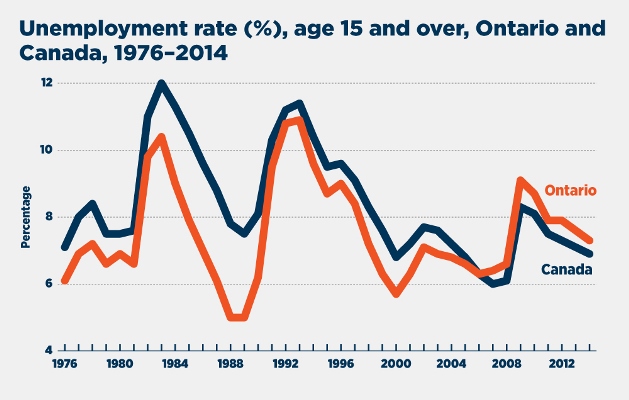Poor policies largely drive Ontario’s lagging labour market performance
This second post on Ontario’s lack of prosperity focuses on unemployment in the province, a key measure of the performance of the labour market. Recall that the first post illustrated the poor economic growth recorded in the province vis-à-vis the rest of Canada.
Ontario traditionally had one of the lowest and most stable unemployment rates in Canada. Ontario’s unemployment rate was below the national average every year from 1976 (when data begin) to 2005. The standard deviation (a measure of variability) of its unemployment rate was the second lowest in Canada, behind Saskatchewan.
Ontario’s unemployment rate first matched the national average in 2006 (at 6.3 per cent), and has been above the national average every year since (see figure below). The gap between Ontario’s unemployment rate and the national average peaked at 0.7 points during the worst of the 2009 recession, and remained half a point higher in 2014, five years into the recovery.

Broader measures of Ontario’s labour market confirm the growing slack in labour demand. Statistics Canada calculates a measure of both unemployment and underemployment, which includes adjustments for involuntary part-time work, discouraged workers, and people waiting to be recalled to work. In 2014, this measure of labour-market slack stood at 10.7 per cent in Ontario, the highest of any province outside of the Atlantic region. Of this 10.7 per cent, two-thirds was accounted for by the conventional measure of unemployment, with the remaining third reflecting various measures of underemployment.
All of the worsening of unemployment in Ontario originated in lower employment. Between its peak in 2004—long before the onset of the 2008 recession—and 2014, Ontario’s employment rate fell by 2.8 points, nearly three times as fast as the next worst-off province. As a result, Ontario’s employment rate went from 1.2 points above national average in 2004 to below the national average in 2014.
Employment was particularly weak in its private sector. The only reason unemployment in Ontario did not surge well above the national average was that the participation rate almost kept pace with the falling employment rate, receding 2.6 points. This also was the largest drop in the country.
Like measures of income performance, Ontario’s labour market performance is lagging largely due to poor policies in the province that make it less competitive and harder (more costly) to do business.
Authors:
Subscribe to the Fraser Institute
Get the latest news from the Fraser Institute on the latest research studies, news and events.

